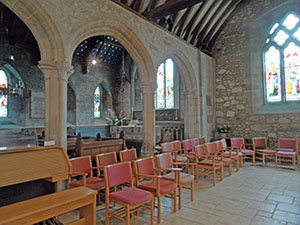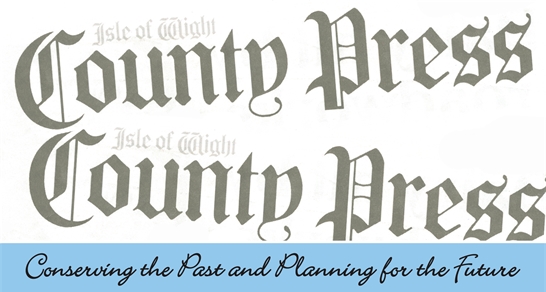July 2023
At the time of the Domesday Book, 1086, there were ten churches on the Island. Now there are 64 Church of England churches, and many other churches and chapels of Christian faiths – and still more buildings to cater for other religions.
First there was the strong Norman style church architecture. This was followed by a lighter build of walls with larger windows.
At Brighstone the internal architecture of the north arcade is late 12th century, with slightly pointed arches.

Brighstone north arcade – late 12th century arches
The pointed “Early English” style arch was developed in the late 1200s, the 13th century, and this continued into the 14th Century. Many of our Island village churches have examples of this style of architecture.

13th Century Early English arches in Shalfleet Church
We must not forget that a building erected in the 12th century cannot be expected to exist for 800 years without some form of repair. Many alterations were carried out. Often a side chapel would be added by a rich landowner in memory of a relation, or the population would increase, necessitating an enlargement of the church. The opposite happened as well, as the Black Death swept over the Island reducing the population, and at this time there was very little building work carried out on churches.
Our two smallest churches are at St Lawrence near Ventnor and at St Boniface, Bonchurch. St Lawrence, the smaller, was a manorial chapel built in the 12th century by the local Lord. In 1305 it became the parish Church, and remained the smallest church in England until the chancel was added in 1842.
St Boniface, Bonchurch
St Boniface church has some 12th century windows with round, not pointed, heads. Recent restoration has been sensitively carried out and the building has been saved from imminent collapse.
Both these churches were so small that, in Victorian times, completely new churches were built to serve the rapidly increasing local population. St Lawrence and old St Boniface remain as excellent examples of early church architecture on the Island, when they served very small communities.
Larger villages, such as Arreton, Brighstone and Freshwater developed larger churches. At Arreton many stages of architecture can be seen, and there were strong links with the original Quarr Abbey. The Arreton south chapel and window is of perfect Early English construction, late 1200s.
Freshwater village church has an unusual tower as you approach the building. The dramatic recessed archway in it is 13th century, with later additions above. Inside, there are some remains of the original small Saxon church, now much enlarged. Much Victorian work was carried out as the population grew, and the Victorians were not averse to moving 13th century windows around within the church, making reading the architecture very complicated!

Freshwater Parish Church, 13th century arch in the tower.
Another impressive church tower is that at Carisbrooke, dated 1471. The church was the parish church as well as the priory church, so survived the destruction of the priory by Henry VIII. The tower is the tallest parish church tower in the Island and Hampshire.

Carisbrooke Parish Church Tower 1470
Enjoy exploring the parish churches of the Island this summer. There is so much to see!
[Go Back]

